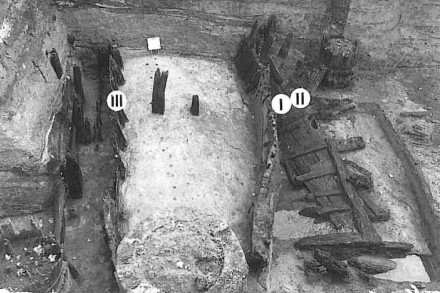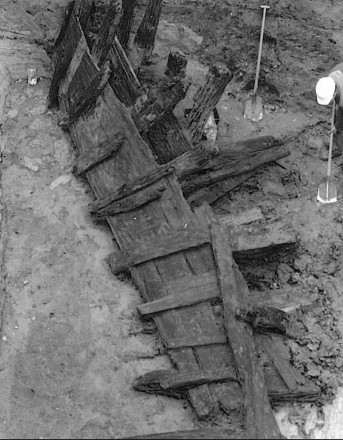History
In 1983, remains of ships were found during archaeological research in the IJsselstraat in the Dutch city of Deventer.
Three medieval quay works that were placed parallel to the river IJssel were found. In these, wooden ship fragments had been reused as revetments. Artefacts found in the vicinity (earthenware) date the embankments between the tenth and the twelfth century. This way of constructing quays with parts of old ships was common in the area in the Middle Ages. The archaeological ship remains were named Deventer I, II and III.

Description
Type: flat-bottomed vessel/barge
A fairly complete chine strake, two bottom strakes and a fragment of a third strake were recovered. The ship fragment consists of oak and measures around 5.4 by 1.1 m. The preserved bottom strakes show no scarf joints.
The outside of the chine, on which the edges are attached in carvel fashion, has been planed off. The bottom parts and sides were joined with arched timbers, which consisted of a frame with a raised branch as the frame part. The frames were fixed with treenails. The chine- and the hull planks were also secured in this way.
The treenails were secured with wedges. The seams of the bottom gates were caulked with moss from below. Moss slats were fastened over this with wooden pegs.
Dendrochronological analysis of the oak wood gives a logging date in the spring of 990 AD. The wood came from the Ardennes.
The Deventer I and III fragments show many similarities with the Utrecht 3.

References
- Vlierman, K. (1996), Kleine bootjes en middeleeuws scheepshout met constructiedetails, Lelystad (Flevoberichten 404/Scheepsarcheologie II) p. 93.
- W. Brouwers/E. Jansma/M. Manders (2015).
Middeleeuwse scheepsresten in Nederland.
Archeo, 2015 (3).
pp 6-24. - E. Mittendorff (2017).
Publicaties Archeologische Depot Overijssel 6 - Tussen Wal en schip.